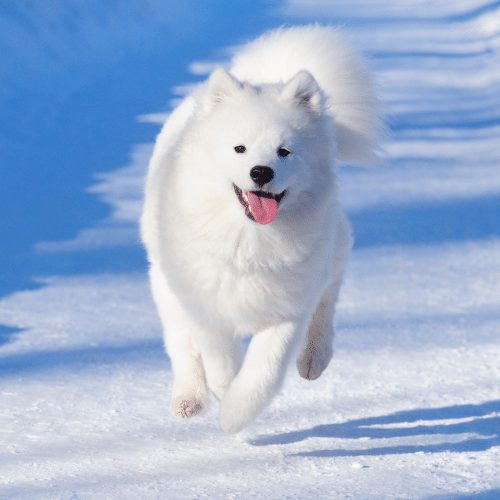Samoyed Puppy Growth Chart & Weight Calculator
May 23, 2021 2022-08-16 17:07If you’re the proud parent of a Samoyed, you may be interested in how large they’ll be as an adult. Enter their current weight and age into our calculator below to get a prediction on their adult size.
Samoyed Weight Calculator & Growth Chart
Table of Contents

How big will my Samoyed get?
The AKC has the following size and weight requirements for Samoyeds:
They typically stands somewhere between 19 to just over 23 inches. Males are a bit larger than females. Usually, males are around 21 to 23.5 inches, while females are 19 to 21 inches. In most cases, there is a visible size difference between adult dogs. Only the largest females and smallest males will overlap.
When it comes to weight, males can weigh between 45 to 65 pounds, while females only weigh 35 to 50 pounds. As you can see, there is a decently large range here. Some Samoyed will be nearly 65 pounds, while others will weigh half that. Be aware of this large range when adopting a Samoyed puppy. Of course, dogs do exist outside of this normal range as well. It isn’t unusual to have an overly small or large Samoyed.
This dog’s white, fluffy coat tends to make them seem even larger than they actually are. Many will look like they weigh quite a lot, but most of it is usually fur!

What does a 3-month Samoyed weigh?
Even at this age, the weight difference between the genders should be obvious. Before puppies are born, their growth is determined by their placement inside their mother’s womb. Some puppies will get more nutrition than others, which will affect their overall size when they are born. However, after they are born, all the puppies get about the same nutrition. For this reason, their genetics play the largest role in how they grow after birth.
By three months, these puppies have been growing based on genetics for long enough to give us a basic idea of what their adult size might be. Larger puppies at this age will likely stay larger, while smaller puppies will usually stay on the small side of things.
By this point, males will weigh between 17.5 to 25 pounds on average. Females will be significantly smaller, only weighing 14 to 17 pounds. Like always, some puppies will fall just out of this average. Dogs that are much lower or higher than this should be seen by a vet to ensure that there isn’t an underlying cause of their large deviation from the norm.
How big is a 6-month-old Samoyed?
By six months, Samoyeds will be well on their way to being fully grown. They should have nearly doubled their weight since they were 3-months-old. Again, females will be significantly smaller than males. Most males will weigh between 32 to 46 pounds, while females will weigh between 26 and 32 pounds. This obvious difference should continue onto adulthood.
You can expect your canine to almost double their weight again until they are fully grown. However, they will grow at a much lower rate from here on out. Much of their growth occurs before six months. The rest of their growth takes significantly more time.
Their mental growth should match this. The difference between a 3-month-old and a 6-month-old puppy is huge. However, 6-month-old and 9-month-old puppies are fairly similar to each other. Despite being almost their adult weight, these dogs will likely still act like puppies. They’ll need high levels of exercise, socialization, and training – even if they are starting to resemble adults.
When is a Samoyed fully grown?
Most Samoyed will continue growing until they are 16 months old. This is just a bit longer than a year. Females typically stop growing sooner than males, as they have less growth to do. Some dogs may not completely stop growing until they are closer to 2 years. The last few months of these dogs’ growth will be focused on gaining muscle mass and fat.
They will likely reach their full height before they reach their full weight. Many may look skinny for a time until they bulk up and gain the appropriate amount of muscle.
You shouldn’t overfeed puppies in an attempt to make them gain muscle and fat too soon. They should grow at their own rate, even if that means they look a bit on the skinnier side for a while. If they consume too many calories while growing, it can lead to joint mishaps and health problems later in life. Some parts of their body may begin to grow out of sync with others, which will obviously cause issues of all sorts.
Is My Samoyed Underweight?
On the one hand, many Samoyeds appear to be underweight for some time when they are growing. They gain height before their gain weight in many causes. At the same time, being underweight can be a considerable problem for a puppy. It can be a sign that there may be an underlying illness that is preventing the dog from using their calories promptly.
The best way to determine if your puppy is underweight is to check their body condition. You should be able to feel the dog’s ribs quite clearly, but you shouldn’t be able to see any more than the last two ribs. If all your dog’s ribs are visible, they are likely underweight.
If you have any questions about your dog’s weight, you should visit your vet. They can weigh your pooch to determine where they are on the growth chart. Being off the growth chart isn’t necessarily a bad thing, but it can indicate a problem if your pooch also shows other signs of being underweight. Some dogs are just small, and that’s okay. However, you don’t want to dog that is built to be large on the bottom end of the growth chart, as this is a clear sign that something is likely wrong.
Treating the underlying problem will likely correct the weight gain problem.

